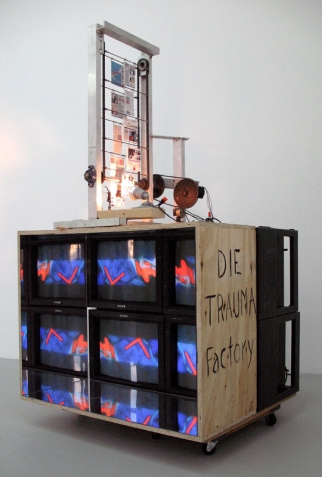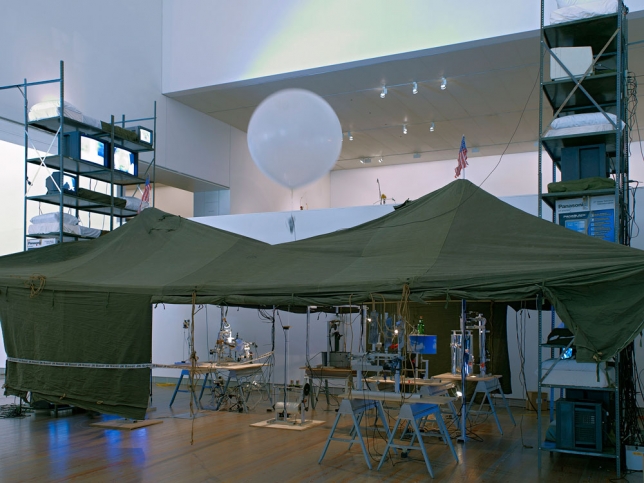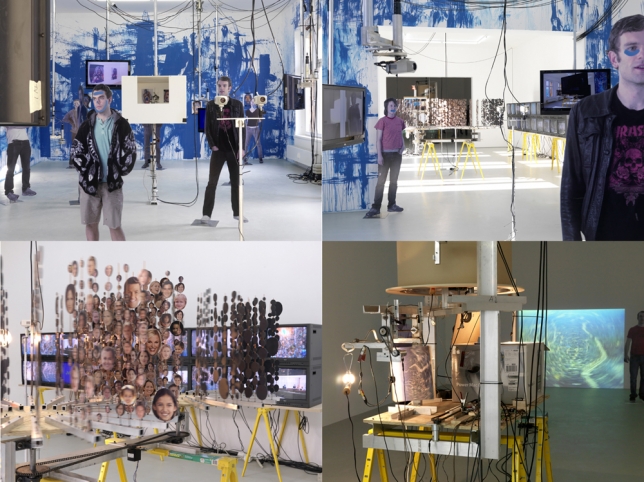27.10. – 24.11.07
Jon Kessler
“The Blue Period”
Solo exhibition at Arndt & Partner, Berlin
Jon Kessler
born in 1957 in Yonkers NY
lives and works in New York City
Jon Kessler creates ingenious spatial scenarios by juxtaposing kinetic multimedia and video installations with a disturbingly high number of surveillance cameras. Despite the technical sophistication, the devices don’t actually work – they only record and transfer to the screens what is to be found “within” the installation.
All we see realized here is the “backstage”, but then, there is nothing in front that could be meaningfully processed.
Kessler displays the entire technical apparatus to us, frustrating any kind of voyeurism by showing that, for the voyeuristic gaze at least, there is nothing to see.
The unsettling and reversing of relations between interior and exterior is also characteristic of installations created around 1970 by artists whose work addressed the relationship between architecture and surveillance, especially Bruce Nauman and Dan Graham. One is filmed, sees oneself from behind or with a time lapse somewhere else in the exhibition. Environments whose construction appears simple develop complex relationships between seeing/not-seeing and being observed/being invisible.
Unlike the early installations by Graham and Nauman, in which one is subjected to a kind of test set-up in more or less closed spaces, in the case of Kessler, the viewer is more like someone tagged with an electronic shackle. You can walk around as you please, but the control system always knows where you are. And when we notice a familiar face on one of the screens, we may be just as surprised as if we had seen it on television.
Besides group exhibitions in e.g. the Whitney Museum of Art, New York (2005), the ZKM, Karlsruhe (2006), the Schirn Kunsthalle in Frankfurt/Main (2007) and the ICA, Philadelphia (2007), he presented solo shows at the P.S.1, New York (2006), the Phoenix Kulturstiftung / Falckenberg Collection, Hamburg (2007), The Drawing Center, New York (2007) and at Louisiana in Denmark (2008). Recent and future presentations include Niet Normaal · Difference on Display (2009 / 2010,) at Beurs van Berlage, Amsterdam and „DEMOCRACY IN AMERICA” at CREATIVE TIME, New York (2009/2010).
EXHIBITIONS:
27.10. – 24.11.07
Jon Kessler
“The Blue Period”
Solo exhibition at Arndt & Partner, Berlin
 Jon Kessler, The Trauma Factory, 2006, mixed media installation, 192 x 91,5 x 101,5 cm /75,59 x 36,02 x 39,96 in, KESS0001
Jon Kessler, The Trauma Factory, 2006, mixed media installation, 192 x 91,5 x 101,5 cm /75,59 x 36,02 x 39,96 in, KESS0001 Robot Dreams - group show with works by Jon Kessler at Museum Tinguely
 Jon Kessler, Kessler's Circus, 2009, installation; Courtesy Fondazione Sandretto Re Rebaudengo; © 2010 Jon Kessler; exhibition view 2010, Daniel Spehr, Basel
Jon Kessler, Kessler's Circus, 2009, installation; Courtesy Fondazione Sandretto Re Rebaudengo; © 2010 Jon Kessler; exhibition view 2010, Daniel Spehr, Basel
Robot Dreams
An exhibition in cooperation with Kunsthaus Graz
Museum Tinguely
9 June to 12 September 2010
Kunsthaus Graz
09 October to 20 Febuary 2011
Exhibitions
PRESS RELEASE
Arndt & Partner is pleased to present Jon Kessler’s solo exhibition “The Blue Period“, opening on October 30th, 2007.
Within the 2nd Floor Gallery, Jon Kessler creates an ingenious spatial scenario with kinetic multimedia and video installations using a numerous surveillance cameras, life size cardboard figures and more elements. Several monitors randomly display the installation in all its variety - the observer unknowingly becoming part of the work - while simultaneously commenting on the omnipresent debate of the developing and powers of visual media and the governmental monitoring of society.
When stepping into the first exhibition room, whose walls are splattered with blue paint, the visitor immediately finds himself amid cross-linked cameras and plasma screens. A miniature upside down reproduction of the gallery space, having small printouts of John Kessler’s collages on the walls, can be found in the centre of the room. Again, the miniature artwork and the view through the windows are being captured by the lens of a little spinning surveillance camera.
In this room the visitor also finds himself in good company, for he is surrounded by life size cardboard figures – personating Kessler’s students from Columbia University – and numerous portraits cut out of magazines displayed upon the walls. The portraits are destabilized by blue paint which functions as a blue screen and allows its displacement by video feeds. What we see on the screens are real-time transmissions from the gallery model, familiar movie clippings showing blue coloured actors – as in Jean-Luc Godard’s “Pierrot le Fou”, Mel Gibson’s “Apocalypto” and “Braveheart” or sequences from the “Blue Man Group” show. Suddenly, the spectator is confronted with his or her own image from various perspectives, for he is being filmed from behind or some other place within the exhibition, as if tagged with an electronic shackle. Besides the visible and obvious technical devices installed in this room, visitors slowly realize that there are even images of the gallery transmitted from the outside. The exact location of this external camera remains unclear, but it appears like the surveillance camera might be installed in one the apartments across the street. An additional site-specific interpretation for “The Blue Period” is possible due to the fact that the Zimmerstraße used to separate the East part of Berlin from the West. Two additional cameras record the work “Mob Scene”, in which a mechanism endlessly spins several plates, which hold approximately 2,500 pictures of smiling faces, extracted from mail–order catalogues. According to the artist, the portraits in this installation are used as a metaphor for captivity, not only in a spatial, but also in an ideal sense. This metaphor reoccurs again in the exhibition’s last installation, named “The Hostage”. Here, one camera captures a blindfolded owl attempting to escape, while the stuffed animal itself is steadily moved up and down in a wooden box. A second camera in motion records an aerial photograph of a cityscape. Finally, a third camera cleaves through the cardboard box. Liberating and enslaving forces portray a game of both captivity and escape attempts.
In the middle of the second room, visitors find the most steadfast work of the exhibition, titled “Random Act of Senseless Violence”. In this work, a reproduction of Edward Hopper’s painting “Nighthawks” is expanded via blue screen. The world outside the diner is displaced with an aggressive and violent mix of images, while concurrently; the figures inside the diner appear to be content with the alienation of outside events. The night owls inside either imagine themselves to be safe or perhaps have already accepted their fate.
Jon Kessler was born in 1957 in Yonkers, New York. He studied at S.U.N.Y. Purchase College and the Whitney Museum of Independent Study Studio Program in New York, where he currently resides and works. Besides group exhibitions at the Whitney Museum of Art, New York (2005), and the ZKM, Karlsruhe (2006), he has also presented solo shows at the P.S.1, New York (2006), and the Phoenix Kulturstiftung / Falckenberg Collection, Hamburg (2007). Currently, Mr. Kessler has exhibits in New York titled “States of Minds, Haus der Kulturen der Welt, Berlin” (24.08.–04.11.07), “Ensemble, ICA” , Philadelphia (07.09.–16.12.07), and “Artmachines – Machine Art”, Schirn Kunsthalle, Frankfurt/Main (18.10.07–27.01.08), and a solo exhibition “The Drawing Center“, New York, (14.09.–25.10.07).
